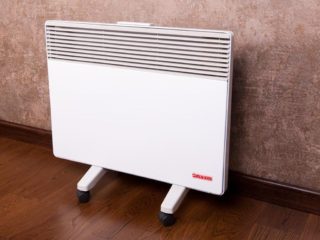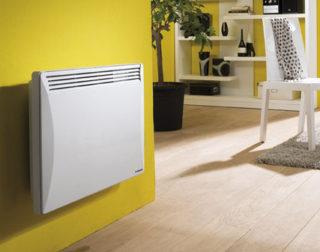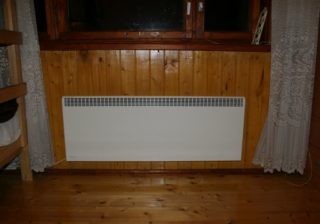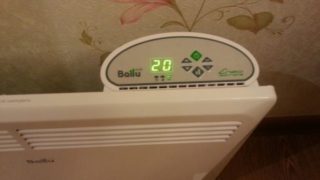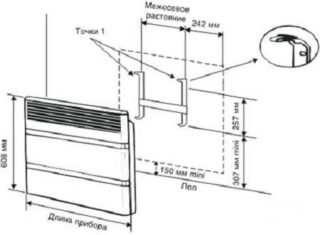For the heating of rooms using a variety of design and principles of operation of the device. When choosing, pay attention to the price of components, installation costs and operating costs. Wall-mounted electric heating convector is affordable and easy to install. A variety of models allows you to choose the device for any conditions.
The purpose of the convector
Quickly heat a private house, a bathhouse, outbuildings using electric heat convectors. A special permit, design and expensive installation are not required for connection, as is the case with gas heating. Work is carried out independently.
The cable leading the electricity to the house and the internal wiring must withstand the connected power of the electric heaters.
Convectors are mainly used for auxiliary heating - appliances are included in the off-season or on particularly cold summer nights. When the gas heating is turned off, the heaters will help wait out interruptions, being a reserve source of heat.
Heating is rarely built solely on convectors because of the high maintenance costs of paying for electricity. In some cases, this option is the only possible or economically feasible, for example, at a high cost of connecting to gas networks.
For the home, energy-saving convector wall heaters are beneficial when it is necessary to urgently supply heat - the installation of the device takes a matter of minutes.
Advantages and disadvantages
The decision in favor of the installation of convectors is made on the basis of a comprehensive assessment of their advantages and disadvantages.
The positive qualities include:
- simplicity of installation and operation - just place the device in the right place and connect it to the mains;
- long term of operation: up to 10 and more years for different types of devices;
- lack of noise during the work;
- automatic or manual adjustment of the required temperature;
- low cost;
- lack of consumables and additional coolant;
- high efficiency - up to 98%;
- a wide selection of equipment in terms of power, design, design.
Serious disadvantages are:
- high fees for energy (electricity) compared to gas heating;
- inefficiency in heating large areas and heights of premises;
- burning of oxygen by some models and the smell of burnt dust at the first start after a break;
- high requirements for the cross section and the state of insulation of electrical wiring.
Having decided on heating the room with convectors, you should study their characteristics, design features and choose the most suitable option.
Operating principle
According to the laws of physics, heated air has a lower density than cold air, which causes warm masses to rise. The process is called “convection”, and electric wall-mounted batteries operating on this principle are commonly called convectors.
The heat source is the heating element or the housing of the device.
Air currents rising to the ceiling displace cooled air down. The circulation process is repeated.
For ease of use and money savings for electricity payments, temperature controllers are built into the heaters, which turn off the device when the desired temperature is reached in the room.
Convector Design
All types of convectors are arranged according to a similar scheme. The device includes:
- a heating element;
- housing;
- Temperature regulator;
- power cord.
In some types of heaters, the heating element is not a separate part, but is mounted in a non-separable case.
Based on the design of each element, manufacturers and sellers carry out the classification of products according to several characteristics.
Temperature Control Options
Devices for controlling the temperature in a room by automatically turning on or off the power of convectors are called thermostats. Electric wall heating radiators are equipped with mechanical or electronic thermostats.
In the first case, the actuator is bimetal plates in the thermal relay. When the convector body reaches the set temperature, the heater power stops. Advantages of this type of mechanism - low price. The disadvantages include the fact that the temperature in the room is not regulated directly, but through the temperature of the convector itself, the degree of heating of the air is not taken into account.
Electronic thermostats take into account the heating of the room and the device. For this, two sensors are built into the device. The microcontroller takes into account both parameters and sets the optimal operating mode of the device.
Types of Heaters
Most devices use needle, monolithic heaters or electric heaters (tubular electric heaters). Each model has inherent features that take into account when choosing a device when buying.
The needle heater is a dielectric body on which loops (needles, spirals) of a nichrome thread are mounted. The wire has a high resistance to electric current, therefore, when a voltage is applied, it quickly heats up to high temperature.
The spiral is in the air, so when heated, oxygen is burned in the room. The element is cooled by a stream of air, part of the energy is spent on the emission of infrared waves.
It is undesirable to use radiators with needle heaters in damp rooms for reasons of electrical safety and in bedrooms due to the burning of oxygen.
While in the air, the nichrome wire heats up quickly and cools quickly, which is why this type of heater is suitable when it is necessary to precisely maintain the temperature in the room.
Heating elements consist of a hollow metal tube, inside of which there is a nichrome wire and electrical insulation material. When voltage is applied, the wire heats the tube. Using additional ribs, increase the heat transfer area, and the housing of the heating element heats up less. Devices with tubular heaters for a long time reach the optimal mode of operation, so they are best used in rooms where a wall-mounted electric heater with a temperature regulator operates in continuous mode.
The design of a monolithic heater may vary, but the principle is the same - the spiral is mounted in a bulk non-separable case, from which the air is heated.
Mounting method
Choosing models that differ in the installation method, they achieve the conditions of high-quality heating, compliance with safety measures and design of the premises.
Wall models are attached to the vertical surfaces of blind walls or under window sills. Sometimes removable legs are attached to such convectors for installation on the floor.
In rooms with panoramic glazing, children's rooms in doorways, built-in energy-saving electric heating convectors with a temperature regulator are mounted. Installation is carried out in recesses of walls, niches, floors. Protective screens will prevent burns to children, protect the device from mechanical damage.
Floor heaters are mobile, with wheels installed as legs on them. Moving the device along the walls or placing it in the middle of the room creates comfortable conditions in a small area. Often in floor models use a combined principle of operation. TEN heats the special oil with which the hollow ribbed body is filled. Such convector radiators are called oily.
Skirting convectors - new appliances on the heater market are suitable for any room. Made in the form of separate devices or built into a special baseboard around the perimeter of the entire room. The height of the heating elements ranges from 60 to 250 mm, and the width is 90–100 mm.
To mask the monolithic heater, special decorative panels are used.
Convection-infrared heaters combine the advantages of both types of heating:
- Strongly heated heating elements emit infrared waves into space, heating objects and people.
- Air, due to the phenomenon of convection, warms the room.
Manufacturers use ceramic or quartz tubes, within which a nichrome spiral is located, as a heating element.
Additional features and service functions
To simplify the adjustment, save energy and maintain a comfortable mode in the room allow additional features that often have modern models.
Choosing economical wall-mounted electric convectors for cottages, they prefer devices with the anti-freeze function. The thermostat of such a device allows you to maintain a temperature of 5-7 degrees in the room. Upon arrival, the house quickly warms up to a comfortable temperature.
The ionizer is useful in the winter when heating appliances dry the air. The built-in ionizer gives O2 molecules a negative charge, which contributes to better oxygen saturation of the blood.
Convectors with an electronic thermostat can be programmed as you wish, setting the turn-on time, the required power and the required temperature in the room.
Remote control allows you to control air heaters from anywhere in the room. Convectors connected to the Smart Home system turn on, turn off, or program over the Internet. This is convenient when you need to warm up the room by the arrival of the tenant.
Electrical appliances are not recommended to be left unattended when turned on. For safety, the circuit into which the convectors are connected must be equipped with differential circuit breakers. Devices instantly turn off the power in the event of a short circuit or "breakdown to the ground."
What power to choose
It is difficult to conduct an accurate heat engineering calculation independently without knowledge in the field of thermodynamics.
To simplify the calculations, two methods are used:
- By area. It operates with a ceiling height of not more than 3 m. For heating rooms 10 m2 with one window, a 1-kW convector is purchased. If the room is angular, apply a coefficient of 1.1. If high-quality thermal insulation of the walls and double-glazed windows are made, the coefficient is 0.8.
- By volume. The volume of the room is multiplied by 0.04 with one window. To the result add 10% to the second, third and each subsequent window.
On average, it is believed that for the organization of additional heating, one should focus on an indicator of 25 W / m3. Basic heating will require a convector power of 40–50 W / m3.
Installation Rules
For mounting wall-mounted electric batteries, use the brackets that come with the kit or are purchased separately. Fasteners must support the mass of the convector.
When mounting, strictly adhere to the manufacturer's instructions. If there is no instruction, they are guided by the distances:
- from the floor - 200 mm;
- to the walls - 20 mm;
- to furniture items closely located on the sides - 200 mm;
- to the windowsill 500 mm;
- from the outlet not less than 300 mm.
- floor-mounted oil convectors are positioned no closer than 250 mm from walls and furniture.
It is impossible to mount complex appliances, such as televisions, over convectors. Rising streams of hot air carry dust that enters the inside of electrical appliances, additional heating is harmful to electronic circuits.
Compliance with the rules promotes good air circulation, interior items will not suffer from overheating and will not lose their attractive appearance.
Manufacturers Rating
When buying a convector, you should give preference to trusted manufacturers with a good reputation. The vast majority of the proposed models work in efficiency of about 95–98%.
The main players in the Russian market are brands:
- Noirot;
- Electrolux;
- Ballu;
- Neoclima;
- Timberk.
The models of the listed manufacturers are reliable, the performance is confirmed by warranty.
Choosing a specific model, pay attention to power, design, additional functions.
The organization of the main and additional heating in private homes and other rooms using wall-mounted electric convectors is quick and cost-effective. Having correctly calculated the power, observing the installation rules, they get comfortable conditions for many years.
